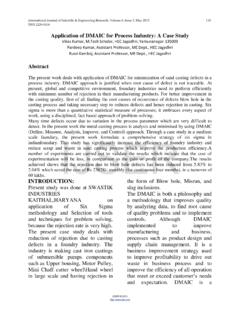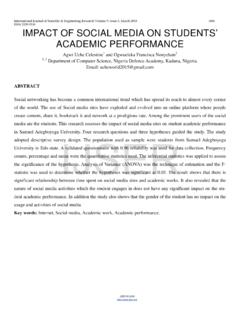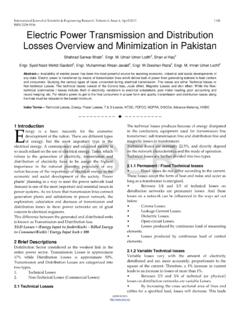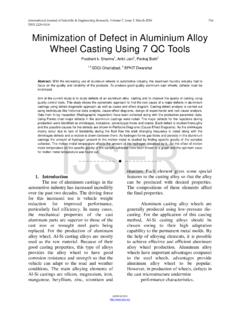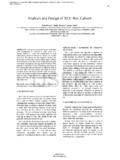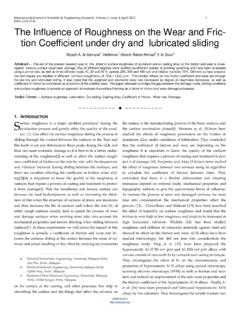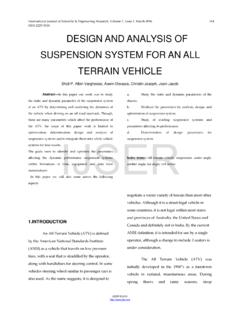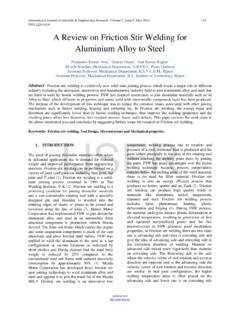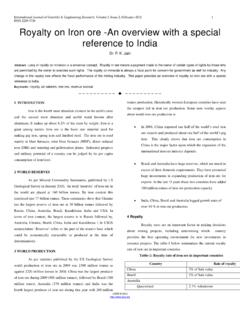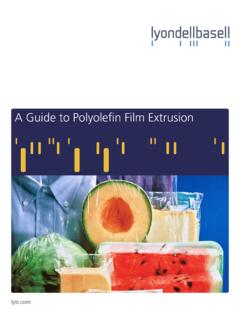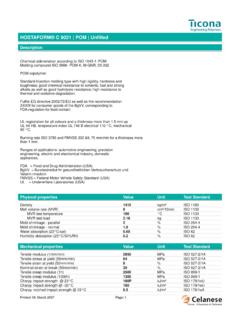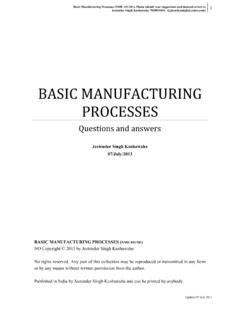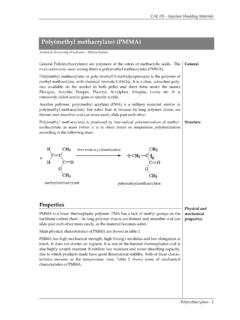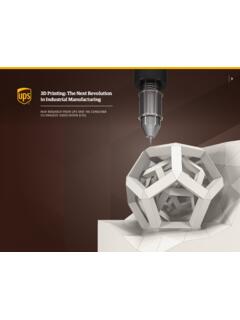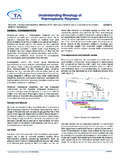Transcription of Mechanical Properties of Glass Fibre Reinforced Polymer ...
1 International Journal of Scientific & Engineering Research, Volume 6, Issue 3, March-2015 145 ISSN 2229-5518 IJSER 2015 Mechanical Properties o f Glass Fibre Reinforced Polymer Based on Resin from Recycled Plastic. *Ephraim M. E. and ** Adetiloye A. *Department of Civil Engineering, Rivers State University of Science and Technology Port Harcourt. **Department of Civil Engineering, Federal University of Agriculture, Abeokuta Abstract: This paper presents the Mechanical performance Properties of Glass Fibre Reinforced plastic GFRP, based on resin recovered from rec ycled plas tic was te.
2 The Glass Fibre Reinforced plastic (GFRP) had a Fibre content varied by weight from 35 to 50% while the thicknesses of the laminate were 10 mm, 12 mm and 16 mm. The Mechanical tests, conducted at room temperature, included tests for density, tensile strength, Izod impact energy, Brinell hardness number and tensile creep behaviour. The average experimental values of density, tensile strength and elongation fell in the range , 43-57 MPa and percent respectively.
3 Practically all the strength characteristics showed maximum values at the Fibre content of 40 percent. The results obtained in this study are in clos e agreement with the trend of variation of these parameters in GFRP, based on virgin resins. This confirms the applicability of GFRP based on recycled resin for structural uses. The successful application of plastic wastes in construction practice will generate multiple benefits of turning waste into wealth, preservation of environment, job creation as well as opening up opportunity for designing smart materials with predetermined Mechanical Properties .
4 Key Words: Glass Fibre , plastic, recycling, Mechanical Properties , environment INTRODUCTION he rapid accumulation of bio-non-degradable plastic wastes in many countries has resulted in growing concern in view of their threats to the environment. In Nigeria, plastic wastes constitute about 10 percent by weight or 20 percent by volume of the total municipal solid waste. Fibre - Reinforced Polymer (FRP), as an emerging technology, has been tested and proven successful.
5 Virgin materials have been used as resin in the development and production of Fibre Reinforced Polymer (FRP) reinforcements for concrete structures and these have found wide applications in the design of aircraft and automobile parts, wind mill blades, sports equipment and in structural use in concrete components and reinforcements. This is because of its inherent characteristics such as corrosion resistance, high strength, light weight and stiffness, and anticipated long-ter m durability.
6 A state-of-the art review on development of FRP can be found in ACI Report 440 [1], Bakis, et al [2], National Cooperative Research Programme [3]. The Mechanical Properties of natural Fibre Reinforced thermoplastic are reported in the work of Garkhai et al [4]. Others include Thomason and Vlug [5], who investigated the influence of Fibre length and concentration on the Mechanical Properties of Glass Fibre Reinforced polypropylene, produced in an injector mould system.
7 In the same vein, Nwabuzor [6] worked on the development of ridft process , incorporating ultraviolet curing technique in which ultraviolet light ray was used in curing the FRP. However, a general dearth of information regarding the Mechanical Properties of recycled waste plastic is observed in technical literature. The summary of previous studies indicate that the Mechanical Properties of Glass Fibre Reinforced plastic (GFRP) products are significantly dependent on type of Fibre , its proportional content and thickness of the specimen.
8 This paper reports the results of a study to determine the Mechanical Properties of Glass Fibre Reinforced polypropylene plastic made with resin, recovered from recycling waste plastics. The principal variables in the study include Fibre content and thickness of laminate. The successful application of plastic wastes in construction practice will generate multiple benefits of turning waste to wealth, preservation of environment and job creation. It will, in addition, open up opportunities for designing smart materials with predetermined Mechanical Properties .
9 RESEARCH METHODOLOGY AND EXPERIMENTAL PLAN The methodology of research covered (i) development of a process for collection, separation and recycling for recovery of polypropylene resin from plastic waste; (ii) fabrication of casting arrangement for the production of Fibre Reinforced plastic product using the recovered resin; (iv) production of recycled waste polypropylene laminates by the hand lay-up method for Fibre T IJSERI nternational Journal of Scientific & Engineering Research, Volume 6, Issue 3, March-2015 146 ISSN 2229-5518 IJSER 2015 concentrations of 35, 40,50 percent and laminate thicknesses of 10, 14, 16 mm.
10 (iii) fabrication and testing of various specimens of GFRP for density, elasticity, hardness, impact and creep. Materials The materials, used in this study were produced from recycled plastic waste which was heated at 280 320 oC, machined and sheared into granular form. The 450 gramme emulsion bonded chopped strand mat was obtained from Manweb Nigeria Limited, Lagos, Nigeria. The granular polypropylene was obtained from an indigenous plastic manufacturer Lasboye Nigeria Limited, also based in Lagos, Nigeria.
